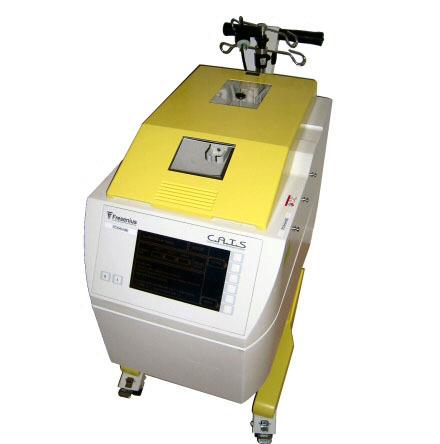Perfusion Policies 101: Autotransfusion

Autotransfusion
- General Description
Intraoperative autotransfusion is used to recover shed blood from the surgical site or post-bypass pump volume. The blood is centrifuged and rinsed with normal saline in a Cell Saver (Haemonetics) or Cobe BRAT (Cobe Cardiovascualr), with the plasma and wash solution being discarded. The resulting washed red blood cells with a hematocrit of 50-55% may then be reinfused to the patient. More than 99% of the heparin is removed during the washing procedure when 1,000 ml of wash solution is used. In addition to cardiac surgery, intraoperative autotransfusion may be used for vascular surgery, orthopedic surgery, neurosurgery, and trauma. The use of intraoperative blood autotransfusion must be restricted to use by a clinical perfusionist. It must be operated, assembled, and maintained under strict supervision. Training is required by the hospital through the Technical Services department of the manufacturer.
- Indications
The procedure is used on the order of an attending physician for the recovery of intraoperative red cells. Because of the expenses involved with both personnel, disposable supplies, and equipment maintenance, the device is usually ordered when blood loss is equivalent to two or more units of red blood cells is expected. Intraoperative autotransfusion is contraindicated in the presence of Avitene or other clotting adjuncts, Betadine, and antibiotics not licensed for pareneteral use, infection or malignancy in the operative field, or contamination of operative field with bowel contents.
The risk/benefit ratio of blood salvage must be determined on an individual basis by the surgeons, anesthesiologists, and transfusion medicine specialists involved in the patient’s care. The responsibility for the use of this device belongs solely to the physician in charge.
- Procedure
Supplies needed: adult or pediatric cell recovery kit, 1,000 ml bag of normal saline with 30,000U heparin, 3,000 ml bag normal saline for wash, Pall blood transfusion filter, and transfer bags. There are no additives to the processed blood.
SETUP
- Inject 30,000U heparin into 1,000 ml normal saline. Label bag, and hang it on the IV pole.
- Place cardiotomy reservoir in holder.
- Open cell recovery pack, record lot #, and place bowl in centrifuge.
- Hang waste bag and attach line from bowl outlet (save caps).
- Place color-coated tubing in the corresponding clamps and attach the blue line to collection bag. Close two small clamps on the drain lines from the collection bag. Attach a Pall transfusion filter and transfer bag to the outlet of one of the drain lines.
- Attach adapter line to the bottom of the cardiotomy reservoir and connect red line from the bowl inlet.
- Attach the yellow line to the 3L normal saline irrigation bag.
- Turn on the device and check operation of all the systems, i.e., computer function, bowl spin and pump operation.
- Open sterile suction assembly and pass suction tubing to scrub nurse, or give it to circulating nurse to pass to the sterile field. When the suction line is passed off to the sterile field, connect to the left ¼” inlet of the cardiotomy reservoir and suction source of-150mmHg.
- Prime the suction line and cardiotomy reservoir with 100ml of the heparin solution, and regulate the heparin drip to 60 drops/min for routine surgery; increase during periods of rapid blood loss.
PROCESSING
Fill bowl in automatic mode, wash with 1,000ml normal saline in automatic mode, and after washing empty bowl into the collection bag. Drain by gravity into a transfer bag. Label with a patient sticker. In addition, note blood volume, date of collection, and expiration time that is 6h from collection time on the sticker. The time and volume of this collected blood should be recorded on the patient’s transfusion record.
- Reinfusion
The processed blood can be retransfused though an intravenous line by an anesthesiologist in the operating room or by a physician or nurse during the postoperative period. Proper identification of the blood unit with the patient’s name and unit number is mandatory. Under no circumstances should the collection bag of the Cell Saver be connected directly to a patient’s intravenous line during intraoperative autotransfusion. The risk of amassive air embolism exists through a direct connection. The blood must be drained by gravity through a filter into a transfer bag that, after being properly deaired and tied off is handed to the anesthesiologist. During bypass, the cells can be reinfused directly into the heart-lung machine by the perfusionist if needed. All reinfusion must be recorded on the patient’s record.
- Recording
An autotransfusion form will become part of the patient’s medical record to document collection and reinfusion of the patient’s own blood. This includes Cell Saver, Plasma Saver, presurgical autologous donation, and postoperative autotransfusions. This can compared with the use of exogenous blood products to document and evaluate the effectiveness of these procedures.
- Centralized Recordkeeping and Reporting
The Clinical Perfusion Department will be responsible for all recording- keeping regarding autotransfusion. This includes the date of service, surgical procedure, number of units collected, lot number and serial number of equipment, and identity nmy of the operator. A quarterly report will be sent to the Blood Bank Director summarizing this data. Reinfusion data will be available on the transfusion record in the patient’s chart.
VII. Preventative Maintenance and Quality Control
Preventative maintenance is performed by a representative of the device manufacturer who will inspect the device on a yearly basis or whenever called by a hospital representative. An unlimited service contract is maintained on all autotransfusion equipment and is renewed on a yearly basis to ensure optimal maximum performance and safe operation of these devices. In addition, Biomedical Engineering will inspect these devices for electrical safety, and will renew these safety stickers before expiration. This will be monitored by Clinical Perfusion Quality Assurance.

